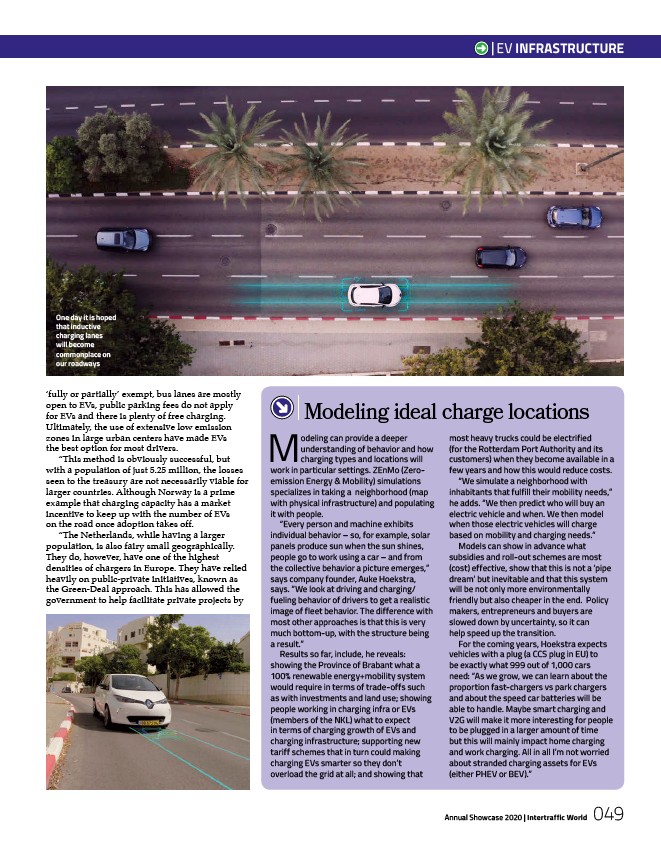
| EV INFRASTRUCTURE
Annual Showcase 2020 | Intertraffic World
049
‘fully or partially’ exempt, bus lanes are mostly
open to EVs, public parking fees do not apply
for EVs and there is plenty of free charging.
Ultimately, the use of extensive low emission
zones in large urban centers have made EVs
the best option for most drivers.
“This method is obviously successful, but
with a population of just 5.25 million, the losses
seen to the treasury are not necessarily viable for
larger countries. Although Norway is a prime
example that charging capacity has a market
incentive to keep up with the number of EVs
on the road once adoption takes off.
“The Netherlands, while having a larger
population, is also fairy small geographically.
They do, however, have one of the highest
densities of chargers in Europe. They have relied
heavily on public-private initiatives, known as
the Green-Deal approach. This has allowed the
government to help facilitate private projects by
Modeling ideal charge locations
Modeling can provide a deeper
understanding of behavior and how
charging types and locations will
work in particular settings. ZEnMo (Zeroemission
Energy & Mobility) simulations
specializes in taking a neighborhood (map
with physical infrastructure) and populating
it with people.
“Every person and machine exhibits
individual behavior – so, for example, solar
panels produce sun when the sun shines,
people go to work using a car – and from
the collective behavior a picture emerges,”
says company founder, Auke Hoekstra,
says. “We look at driving and charging/
fueling behavior of drivers to get a realistic
image of fleet behavior. The difference with
most other approaches is that this is very
much bottom-up, with the structure being
a result.”
Results so far, include, he reveals:
showing the Province of Brabant what a
100% renewable energy+mobility system
would require in terms of trade-offs such
as with investments and land use; showing
people working in charging infra or EVs
(members of the NKL) what to expect
in terms of charging growth of EVs and
charging infrastructure; supporting new
tariff schemes that in turn could making
charging EVs smarter so they don’t
overload the grid at all; and showing that
most heavy trucks could be electrified
(for the Rotterdam Port Authority and its
customers) when they become available in a
few years and how this would reduce costs.
“We simulate a neighborhood with
inhabitants that fulfill their mobility needs,”
he adds. “We then predict who will buy an
electric vehicle and when. We then model
when those electric vehicles will charge
based on mobility and charging needs.”
Models can show in advance what
subsidies and roll-out schemes are most
(cost) effective, show that this is not a ‘pipe
dream’ but inevitable and that this system
will be not only more environmentally
friendly but also cheaper in the end. Policy
makers, entrepreneurs and buyers are
slowed down by uncertainty, so it can
help speed up the transition.
For the coming years, Hoekstra expects
vehicles with a plug (a CCS plug in EU) to
be exactly what 999 out of 1,000 cars
need: “As we grow, we can learn about the
proportion fast-chargers vs park chargers
and about the speed car batteries will be
able to handle. Maybe smart charging and
V2G will make it more interesting for people
to be plugged in a larger amount of time
but this will mainly impact home charging
and work charging. All in all I’m not worried
about stranded charging assets for EVs
(either PHEV or BEV).”
One day it is hoped
that inductive
charging lanes
will become
commonplace on
our roadways